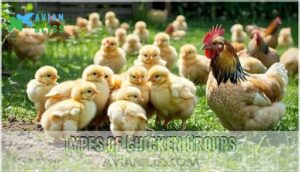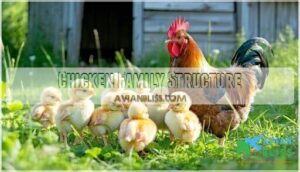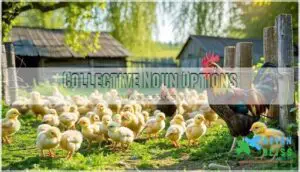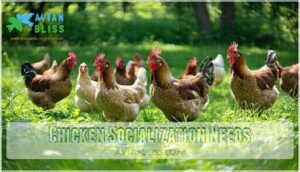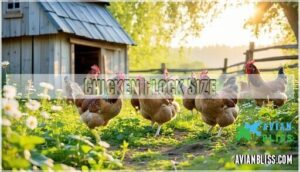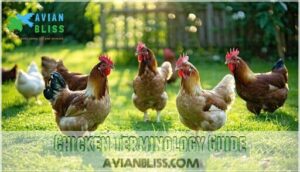This site is supported by our readers. We may earn a commission, at no cost to you, if you purchase through links.
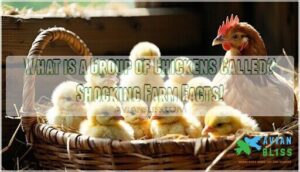
If you’re talking about hens and their chicks, that’s a brood.
Have a clutch of eggs ready to hatch? That’s also a clutch of chickens.
And if there’s a bunch of chicks peeping around? That’s a peep.
Chickens are highly social, whether they’re in the backyard or strutting around a farm.
They form complex hierarchies—a “pecking order,” literally—so understanding their group dynamics is key to keeping a happy flock.
Ever wondered how roosters fit into the mix? Let’s just say, it gets interesting!
Table Of Contents
- Key Takeaways
- Chicken Flock Behavior
- Types of Chicken Groups
- Chicken Family Structure
- Collective Noun Options
- Chicken Socialization Needs
- Wild Chicken Flocking
- Chicken Flock Size
- Chicken Terminology Guide
- Frequently Asked Questions (FAQs)
- What is a group of hens called?
- What is a group of Roosters called?
- What is a flock of chickens called?
- What is a group of baby chickens called?
- What is a group of chickens?
- What is a group of chicks called?
- What is a pack of chickens called?
- What is a clan of chickens?
- What word is used to describe a group of hens?
- What is a number of chickens together called?
- Conclusion
Key Takeaways
- A group of chickens is usually called a flock, but for hens and chicks, it’s a brood, and for baby chicks, it’s a peep.
- Chickens are social creatures that form pecking orders to maintain harmony and share resources.
- Roosters play key roles in hierarchy, protection, and reproduction within the flock.
- Understanding chicken group terms like flock or brood helps you better appreciate their social dynamics and interactions.
Chicken Flock Behavior
You’ve probably never wondered what happens inside a chicken flock, but their social world is more fascinating than you might think.
When chickens gather together, they’re not just hanging out—they’re creating complex social networks with intricate hierarchies that would put some corporate office structures to shame.
Social Dynamics
Pecking their way through social landscapes, chickens reveal a fascinating world of communication and cooperation.
Chickens build intricate networks, proving there’s more to their pecking order than meets the eye.
Your backyard flock isn’t just a random group—it’s a complex social network where chickens learn, interact, and survive together.
They share information, warn each other about dangers, and develop intricate social bonds that guarantee group stability and survival.
Hierarchies
Because chickens are inherently social, they naturally develop intricate hierarchical structures within their flocks.
The pecking order determines each bird’s social rank, with dominant birds leading through subtle behavioral cues.
These social interactions establish clear boundaries, ensuring smooth group dynamics and minimizing conflicts through an unspoken yet powerful chicken social structure.
Dominant Hens
At the heart of the hen hierarchy, dominant females rise to the top by asserting their social status.
These flock leaders use strategic pecking order techniques to establish and maintain control.
Through subtle body language and calculated interactions, dominant hens command respect, dictating access to resources and influencing the entire chicken social structure with remarkable precision.
Dominant hens use these strategies to maintain their position, ensuring they remain at the top of the hierarchy.
Types of Chicken Groups
You might be surprised to learn that chickens aren’t just random birds running around, but complex social creatures with fascinating group dynamics.
When you observe a flock, you’ll discover that chickens have specific collective nouns and intricate social structures that reveal their remarkable ability to live and work together.
Roosters
Exploring the rooster’s domain reveals fascinating insights into chicken social dynamics. Male chickens play vital roles in flock leadership and reproduction.
Here’s what makes roosters unique:
- Establish and maintain flock hierarchies
- Protect hens from potential predators
- Lead foraging and resource discovery
- Perform elaborate courtship displays
Rooster behavior epitomizes male dominance in chicken social structures, ensuring survival and reproductive success through strategic leadership and vigilant protection. Proper rooster care involves understanding rooster health needs.
Hens
In the vibrant world of hen behavior, female chickens thrive in close-knit groups, revealing intricate social dynamics.
These egg-laying champions form tight bonds within their chicken flock, establishing complex hierarchies and communication networks.
Their collective nature guarantees survival, with each hen playing a vital role in maintaining the delicate balance of flock dynamics and chicken terminology.
Mixed Flocks
Ever wondered how hens mix it up beyond their usual cliques? Mixed flocks are nature’s social network for chickens!
Fascinating mixed flock insights:
- Include 2+ bird species
- Maximize feeding efficiency
- Boost predator protection
- Form dynamic social groups
These collaborative crews typically range from 10-40 individuals, showcasing chickens’ incredible social adaptability and group survival strategies. Who knew feathered friends could be such networking pros?
Chicken Family Structure
You’ve probably wondered how chicken families work, with their complex social structures and fascinating group dynamics.
Understanding the roles of mother hens, chicks, and roosters can reveal the intricate world of chicken family life, where survival and reproduction depend on their tight-knit social bonds.
Mother Hens
When different chicken groups mix, mother hens emerge as nurturing powerhouses of the flock.
Their instincts drive remarkable brood management strategies that guarantee chick survival.
Check out this quick guide to hen motherhood:
| Behavior | Characteristic | Impact |
|---|---|---|
| Protective | Guards chicks | Survival |
| Nurturing | Teaches foraging | Learning |
| Hormonal | Broody instinct | Reproduction |
Mother hens aren’t just egg-layers—they’re feathered caregivers who keep their little ones safe and sound, demonstrating a strong broody instinct.
Chicks
In the tender world of baby chicks, these fluffy bundles of life burst with potential and curiosity.
Chick care involves nurturing their delicate development through critical early stages.
Your tiny feathered friends require special attention with:
- Precise chick feed suited to nutritional needs
- Controlled temperature in a safe brooder environment
- Consistent monitoring of chick health indicators
Roosters Role
Right in the midst of a chicken group, roosters emerge as natural leaders, standing guard with muscular determination.
They protect the flock from predators, sound alarms when threats approach, and break up hen conflicts.
With a recommended ratio of 8-12 hens per rooster, these males play a vital role in fertilizing eggs and maintaining social harmony within the chicken collective.
The social hierarchy of chickens is influenced by their dominance hierarchy, which guides their behavior and interactions, and is a key factor in their dominance hierarchy.
Collective Noun Options
You might be surprised to learn that chickens have more than one collective noun to describe their social groups.
From the adorable "peep" of baby chicks to the scientific term "flock", these feathered friends have a fascinating linguistic range that reflects their complex social behaviors.
Brood Meaning
After nurturing your chicks, you’ll understand why "brood" is more than just a word—it’s a chicken family saga.
Brood describes as well as a group of chickens but also the maternal act of sitting on eggs.
When a hen gathers her peeping youngsters, she’s literally creating a brood, showcasing the intricate social bonds of chicken family dynamics, and this is a key part of the maternal act.
Flock Meaning
Among chicken enthusiasts, "flock" stands as the quintessential term for a group of chickens.
This collective noun captures their intricate social dynamics perfectly.
Understanding flock characteristics reveals fascinating insights into chicken behavior:
- Groups typically range from 3-10 birds
- Hierarchies emerge naturally within flocks
- Social interactions define their collective experience
Chicken social structure thrives on these interconnected relationships, making flock management a delicate dance of instinct and communication.
Peep Meaning
Some curious minds wonder what a group of baby chicks is called.
A "peep of chicks" captures the adorable chirping sounds these fledgling feathered friends make.
Check out this quick reference guide:
| Term | Description |
|---|---|
| Peep | Young chicks making soft chirping sounds |
| Group | Collective noun for chicken offspring |
| Sound | High-pitched chirping communication |
| Origin | Derived from chicks’ distinctive vocal patterns |
Peep perfectly describes the endearing chorus of young chickens, which is a collective sound made by the chicks.
Chicken Socialization Needs
Chickens are social animals that need companionship to thrive, and isolation can lead to stress and depression.
By understanding their social needs, you’ll help your flock establish healthy bonds and avoid unnecessary squabbles.
Loneliness
Loneliness hits chickens harder than you’d think.
Social isolation can lead to chicken depression, anxiety, and even poor health.
Flock loneliness disrupts chicken social behavior, making them stressed without their group.
To prevent isolation effects:
- Keep at least three chickens together.
- Make certain chicken groups include companions they trust.
- Provide enrichment like toys or dust baths.
Making access to chicken toy options available can help alleviate stress and support the overall well-being of the chickens by promoting a healthy and social environment.
Aggression
Chickens can ruffle more than feathers when aggression flares up.
Flock violence like aggressive pecking or rooster attacks often stems from crowded spaces, genetics, or stress.
Feather pecking can spiral into chicken fighting, disturbing the group’s harmony.
Address chicken aggression by observing their social behavior.
Recognizing triggers helps reduce injuries and keeps your flock calm.
Nobody likes a grumpy rooster!
Understanding flock dynamics is essential to maintaining a peaceful and healthy chicken environment.
Pecking Order
The pecking order is the backbone of chicken social hierarchy, keeping flock dynamics in check.
Dominant hens take charge, guaranteeing order and access to resources. Social ranks might sound harsh, but they’re essential for chicken harmony and group stability.
- Key features of the pecking order:
- Guarantees fair resource distribution.
- Reduces fights within the flock.
- Strengthens chicken behavior cohesion.
Wild Chicken Flocking
When chickens live in the wild, they naturally gather in small flocks for safety and social bonding. These groups, guided by strict hierarchies, help protect against predators and guarantee survival.
Feral Chicken Behavior
Feral chickens often form loose flocks, showcasing fascinating chicken behavior.
They’re skilled at wild roaming, adapting to urban areas while retaining their survival instincts.
Despite their chaotic appearances, feral flocks rely on sharp flock dynamics and collective vigilance for safety.
Chicken social behavior shines through their calls and pecking orders, proving these urban chickens are far from directionless wanderers, with a notable display of collective vigilance.
Social Hierarchies
Within any flock, chicken hierarchy is serious business.
The pecking order isn’t just a cute term—it’s real etiquette! Hens constantly assess dominance, with the top chicken controlling prime resources, like food and roosting spots.
A dominant rooster enforces social structure, keeping skirmishes low, and organized chaos is a notable aspect of their behavior.
Watching their flock dynamics reminds you how even chickens have a knack for this organized chaos.
Predator Avoidance
When danger lurks, a flock’s safety relies on sharp instincts and teamwork.
Flock survival depends on quick instincts, teamwork, and the unwavering vigilance of chickens protecting their own.
Chickens use alert systems, like warning clucks, to signal predators.
Roosters often act as sentinels, scanning for threats.
Camouflage techniques, such as dust bathing, help blend with surroundings.
Guard animals, like dogs, are great predator deterrents.
These chicken survival strategies show just how clever flock behavior truly is!
Flocks also utilize advanced predator avoidance techniques to enhance their safety and make use of clever tactics.
Chicken Flock Size
You might think chickens flock together in huge numbers, but it actually depends on their environment and purpose.
Whether you’re managing a backyard coop or observing wild chickens, understanding flock size can help you keep them happy and healthy, which is crucial for their overall well-being and your success in managing them.
Minimum Size
A small group of chickens thrives best with a social minimum of three birds to guarantee healthy group dynamics.
This size works for proper flock social structure, avoiding loneliness or bullying.
The minimum birds in a flock help maintain balance and peace—chickens don’t like being lone rangers.
For harmony, think “three feathers and a friend!”
Chicken collective nouns like "flock" fit perfectly.
Proper bird care advice, including cage size requirements, is essential for maintaining healthy birds.
Average Size
In the context of flock numbers, the average flock size varies but most backyard chicken keepers stick to small groups of 6-10 birds.
Chicken social groups thrive within this range.
Here are typical chicken counts:
- 3-5: Beginners often start small.
- 6-10: Ideal for backyard setups.
- 11-15: Larger urban-friendly flocks.
- 20+: Serious chicken enthusiasts!
Large Flocks
When managing large flocks, things get lively fast—think a bustling town square, but with feathers.
Farms often house hundreds or thousands of chickens in massive coops. Proper flock management is key for poultry health, social stability, and reducing stress.
Here’s a quick comparison of flock sizes:
| Flock Size | Birds Count | Space Needed | Coop Type | Social Challenges |
|---|---|---|---|---|
| Small | 3-10 | Minimal | Backyard | Low |
| Medium | 10-50 | Moderate | Hobby | Moderate |
| Large | 50-500 | Extensive | Farm | High |
| Industrial | 500-10,000+ | Massive | Facility | Complex |
| Free-Range Large | 50-1,000 | Outdoor | Movable/Run | Varies |
The table highlights the differences in flock sizes, including the number of birds, space needed, coop type, and social challenges associated with each size, emphasizing the importance of social stability and reducing stress in flock management.
Chicken Terminology Guide
You’ll find chickens have their own unique set of terms that describe their age, gender, and roles in a flock.
Understanding these names helps you talk about chickens accurately, and maybe impress a farmer or two.
Breeding Terms
In regards to chicken breeding, terms like "Brood Size" refer to the number of chicks hatched together, while "Hatch Rates" show your success in incubation.
"Hybrid Breeds" are specially crossbred for better eggs or meat.
Understanding "Flock Genetics" helps improve your farm’s sustainability.
This chicken terminology list is essential for managing your flock and mastering Layer Management effectively! Mastering chicken breeding terms is vital for a successful farm.
Age Terms
Chickens go through fascinating growth stages!
Chicks are the fluffy babies (under 12 weeks old).
Young females, called pullets, are in the juvenile stage before becoming egg-laying hens at one year.
Meanwhile, young males are cockerels and mature into roosters.
Understanding chicken ages helps with pullet care, chick development, and gauging hen maturity.
It’s like tracking milestones—feathery ones!
Gender Terms
Did you know chickens have their own gender-specific terms? A hen is an adult female, while a pullet is a younger, not-yet-laying lady.
Roosters, the bold leaders, contrast with cockerels, their young, developing counterparts.
Hen roles often involve nesting and mothering, while rooster behavior centers on protection and mating, highlighting fascinating chicken terminology and shaping chicken social dynamics.
Frequently Asked Questions (FAQs)
What is a group of hens called?
A group of hens is often called a flock, but if they’ve been raised together, you can also call them a brood.
It’s like a little chicken family, complete with sisterly squabbles!
What is a group of Roosters called?
A group of roosters is like a council of kings—technically called a flock, though there’s no unique term.
Their vibrant plumage and rivalry can create quite the spectacle, filled with chest-puffing and territorial showdowns.
What is a flock of chickens called?
You’d call a group of chickens a “flock.” This term works whether they’re hens, roosters, or a mix.
For baby chicks, “peep” fits perfectly.
Think of chickens as social, feathery family units!
What is a group of baby chickens called?
A bunch of baby chickens is called a "peep."
It’s a fitting name because of their tiny, chirpy sounds.
Picture a soft, feathery orchestra of squeaks—adorable chaos in motion, isn’t it?
What is a group of chickens?
Imagine this—chickens strutting around like feathered royalty.
You’d call that a flock, the universal term for their social squad.
Depending on the situation, brood, peep, or even clutch might fit better.
Charming, isn’t it?
What is a group of chicks called?
When you’ve got a cluster of baby chicks, you call it a "peep."
It fits their tiny, chirping personalities perfectly.
It’s like naming a jazz band—they’ve got the sweet sound to match!
What is a pack of chickens called?
A group of chickens is usually called a flock.
If they’re chicks, it’s a peep, and for hens raised together, it’s a brood.
However, no matter the name, they’re always a lively bunch!
What is a clan of chickens?
A clan of chickens doesn’t follow the textbook definition of clans in other species.
Instead, you’d call them a flock or brood.
Chickens value unity, but they thrive in pecking-order dynamics over familial bonds.
What word is used to describe a group of hens?
When describing a group of hens, you can call it a flock or a brood—especially if they’ve been raised together.
"Brood" adds a cozy, family feel.
Honestly, chickens are all about teamwork!
What is a number of chickens together called?
You’d call a number of chickens together a "flock."
If they’re baby chicks, it’s a "peep," and for a family unit, a "brood."
Chickens naturally prefer to stick together—safety in numbers, after all!
Conclusion
You’d think naming a group of chickens would solve world mysteries!
A group of chickens is most commonly called a flock, but it can also be a brood, clutch, or peep, depending on the context.
Chickens thrive in social groups, forming pecking orders and unique bonds.
Understanding terms like "brood" for hens and chicks or "peep" for baby chicks helps you appreciate their complex dynamics.
Keep your flock social, and they’ll reward you with harmony—and maybe eggs!

